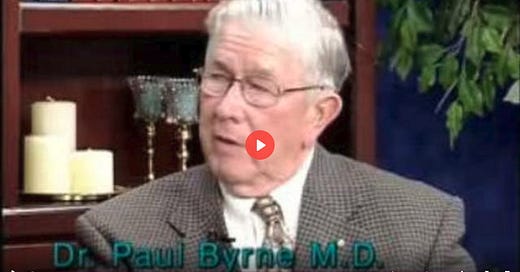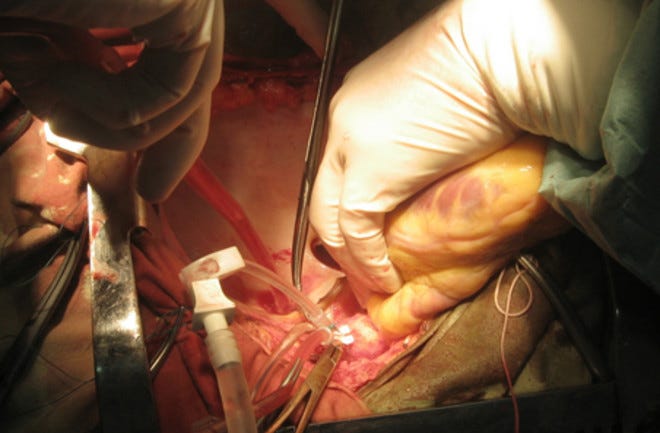VERY DISTURBING: Brain Death Is A LIE. Don't Donate Your Organs – Dr. Paul A. Bryne
Every donor is killed in the process, he stated. Revoking your organ donation status from your drivers license is not enough, you must also complete a document of refusal.
One-time or recurring donations can be made through Ko-Fi:
Dr. Paul A. Byrne is a Board Certified Neonatologist and Pediatrician. He is the Founder of the Neonatal Intensive Care Unit at SSM Cardinal Glennon Children’s Medical Center in St. Louis, MO. He is Clinical Professor of Pediatrics at University of Toledo, College of Medicine. He is a member of the American Academy of Pediatrics and Fellowship of Catholic Scholars.
Dr. Byrne is past-President of the Catholic Medical Association (USA), formerly a Clinical Professor of Pediatrics at St. Louis University in St. Louis, MO, and Creighton University in Omaha, NE. He is the author and producer of the film “Continuum of Life” and the author of the books “Life, Life Support and Death,” “Beyond Brain Death,” and “Is ‘Brain Death’ True Death?”
Dr. Byrne has presented testimony on “life issues” to nine state legislatures beginning in 1967. He opposed Dr. Kevorkian on the television program “Cross-Fire.” He has been interviewed on Good Morning America, public television in Japan, and participated in the British Broadcasting Corporation Documentary “Are the Donors Really Dead?”
Although the medical profession declares patients “brain dead,” often following an accident, Dr. Byrne insisted there’s no such thing. "Brain death" was false, he said. “Brain death was a lie from the beginning. It has always been a lie. "Brain death" is not true death,” he continued. Organ transplant is the reason you have to have brain death.
Dr. Byrne said this term crept into the medical profession following the world’s first heart transplant in 1968. It has since been defined and redefined and is now being replaced by another term known as cardiac death, he noted.
He said donated organs, without exception, must come from a living person. Within minutes of “true death,” which, he explained, is the cessation of circulation and respiration, the organs will begin to die. This is why, when organs are removed from a donor, the beating heart is always taken last. You cannot get any organs from cadavers, he noted.
If you’re really dead, then no organs can be extracted. He also pointed out the differences between living and dead patients. One example is cooling the body. This slows metabolism in someone who is alive. It slows destruction in a corpse. He said a ventilator, which pushes air into the body, can only be used on someone who’s living, as the person exhales the air. Also, if you cut the skin of someone who’s living, but declared “brain dead,” the wound will heal, something that won’t happen in a dead person. Clearly, there’s a difference, said Dr. Byrne.
Dr. Bryne went on to describe the damage that can result when doctors perform an “apnea test,” which often sets the stage for organ donation. This is when a ventilator is removed, prematurely, for 10 minutes, to see if a person can breathe on their own. This process, which he called “suffocation,” typically results in the person’s conditioning worsening, he said.
Recovery after being declared “brain dead” is also possible according to Dr. Byrne's personal experience and research.
The Beating Heart Donors
They urinate. They have heart attacks and bedsores. They have babies. They may even feel pain. Meet the organ donors who are “pretty dead.”
By Dick Teresi Feb 19, 2012
In 1968, thirteen men gathered at the Harvard Medical School to virtually undo 5,000 years of the study of death. In a three-month period, the Harvard committee (full name: the Ad Hoc Committee of the Harvard Medical School to Examine the Definition of Brain Death) hammered out a simple set of criteria that today allows doctors to declare a person dead in less time than it takes to get a decent eye exam. A good deal of medical language was used, but in the end the committee’s criteria switched the debate from biology to philosophy. Before many years went by, it became accepted by most of the medical establishment that death wasn’t defined by a heart that could not be restarted, or lungs that could not breathe. No, you were considered dead when you suffered a loss of personhood.
But before we see what substituting philosophy for science actually means to real patients, let’s look at the criteria the Harvard authors believed indicated that a patient had a “permanently nonfunctioning brain”:
• Unreceptivity and unresponsivity. “Even the most intensely painful stimuli evoke no vocal or other response, not even a groan, withdrawal of a limb or quickening of respiration,” by the committee’s standard.
• No movements or spontaneous breathing (being aided by a respirator does not count). Doctors must watch patients for at least one hour to make sure they make no spontaneous muscular movements or spontaneous respiration. To test the latter, physicians are to turn off the respirator for three minutes to see if the patient attempts to breathe on his own (the apnea test).
• No reflexes. To look for reflexes, doctors are to shine a light in the eyes to make sure the pupils are dilated. Muscles are tested. Ice water is poured in the ears.
• Flat EEG. Doctors should use electroencephalography, a test “of great confirmatory value,” to make sure that the patient has flat brain waves.
The committee said all of the above tests had to be repeated at least 24 hours later with no change, but it added two caveats: hypothermia and drug intoxication can mimic brain death. And since 1968, the list of mimicking conditions has grown longer.
Although the Harvard criteria were based on zero patients and no experiments were conducted either with humans or animals, they soon became the standard for declaring people dead in several states, and in 1981, the Uniform Determination of Death Act (UDDA) was sanctioned by the National Conference of Commissioners on Uniform State Laws. The UDDA is based on the Harvard Ad Hoc Committee’s report. That a four-page article defining death should be codified by all 50 states within 13 years is staggering.
Just as some of our ancestors saw the heart as the locus of the soul, today the medical establishment assumes that the brain is what defines humanity and that a functioning brain is vital to what is called a human being’s personhood. D. Alan Shewmon, a pediatric neurologist at UCLA who was originally pro–brain-death, now dismisses the idea. The most scientific approach one can take to death, he says, is to treat human beings like any other species. People should be judged biologically on whether they are alive or dead, not on some vague notion of personhood. There is no abstract notion of “squirrelness,” for example, or “gorillahood,” by which we determine the death of other species.
The question is: Why do we even need concepts like personhood and brain death? Despite heroic efforts to clarify and justify the Harvard criteria, they remain opaque, confusing, and contradictory. If, as proponents say, brain death criteria describe the same condition—i.e., death—as the cardiopulmonary criteria, why bother? Especially since the tools are available for declaring cardiopulmonary death, and are sorely lacking, or at least ignored, for determining whether the whole brain is really dead.
Shewmon compiled 150 documented cases of brain-dead patients whose hearts continued to beat, and whose bodies did not disintegrate, past one week’s time. In one remarkable case, the patient survived 20 years after brain death before succumbing to cardiac arrest.
Brain-death advocates have always insisted that anyone who meets their criteria will fall apart quickly, and go quickly to meet the cardiopulmonary criteria. Yet Shewmon presents a litany of life processes that brain-dead patients continue to exhibit:
• Cellular wastes continue to be eliminated, detoxified, and recycled.
• Body temperature is maintained, though at a lower-than-normal temperature and with the help of blankets.
• Wounds heal.
• Infections are fought by the body.
• Infections produce fever.
• Organs and tissues continue to function.
• Brain-dead pregnant women can gestate a fetus.
• Brain-dead children mature sexually and grow proportionately.
So what drove the Harvard Ad Hoc Committee to turn back the calendar and construct a lower standard for death? To a growing number of scientific critics it appears that the committee was fixated on freeing up human organs for transplant. Continue reading







This interview is profound and puts into question what I thought I knew. I worked in critical care most of my career. I remember assisting in one of those apnea tests that he is talking about towards the end of the video. The doctor came in and did all of the brain stem testing and disconnected the ventilator, the patient was apneic and the CO2 of course went up tremendously and the doctor was not going to reconnect the patient because he said once you do the brain death exam they are required to not put the patient back on life-support. I was horrified because the patient’s family had yet to come in and say their goodbyes, and I made him put that patient back on the ventilator! It was so cold and callous I couldn’t believe it! This was going to be a terminal extubation not an organ donation situation because he was going to just leave the ventilator off! I also witnessed neurologists declare 2 young patients (in that 20-30yr age group) as being in a vegetative state and not going to wake up. Both patients were from very different backgrounds: race, socioeconomic, cultural, but both had very religious parents who prayed and had their family, friends, community and church groups praying and both woke up! That experience with those two patients forever changed my mind of what was possible and the power of prayer!
Yep, I've been a nurse for 25 years and I stumbled across an article on LifeSite News a year or so ago about this same subject. I was floored. I spent several years working in critical care also and have taken care of several patients who ended up organ donors, as well as many who had some kind of head trauma and were considered "brain dead". It really turns your whole world upside down to learn that something you've been taught and practiced for years is a HUGE LIE; especially when it involves people's LIVES. What's even worse is, the doctor in the article I read said all it takes to wake these comatose people up is replacement of three simple hormones, something that can easily be done these days. I think about how many people I have taken care of who were in that state and it just makes me want to scream, now knowing they could've been helped and their families could have had their loved one back.
https://www.lifesitenews.com/news/neurologist-exposes-brain-death-myth-behind-multi-billion-dollar-organ-transplant-industry/